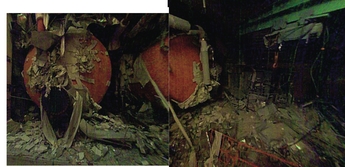A camera hung from a helium balloon has taken pictures of destruction on the Fukushima Daiichi unit 1 fourth floor, including apparently the A&B isolation condensers, whose failure played an important role in the worsening of the emergency in the hours after the tsunami.

Workers launched the balloon to try to assess the state of the upper floors of the Fukushima Daiichi unit 1 reactor building, where high radiation levels and debris have blocked access. The 3m-diameter balloon was inserted into the equipment hatch shaft, and rose as high as the 4th floor before running up against an obstacle that blocked its further ascent.



In other news, workers have lowered the unit 4 PCV upper vessel lid from the unit 4 operating floor (level 5). The lid was taken off of the vessel during the refuelling outage that preceded the 11 March earthquake and tsunami. For the past few months, workers have been removing rubble and large structures from the top of the building, in preparation for installing a cover on the top of the building to support operations to remove spent fuel from the pool.
TEPCO has released an update to its December 2011 report of the incident in English. The primary purpose of the update seems to be to rebut criticism of the company, and present its point of view.
It reviewed its history of preparation of tsunami defences, arguing that uncertainty of estimation models and the likelihood of earthquakes along the Japan Trench prevented it from upgrading its tsunami defences. Results of probabilistic safety analysis evaluation of earthquakes carried out in the early 1990s were highly uncertain, and warranted further deliberation on how to apply them to the plant.
Accident management measures were inadequate to cope with the incident, "and the expansion of the accident could not be prevented under the framework of the prepared safety measures." Lack of availability of communication lines with for example Namie Town prevented TEPCO from updating it with information until 13 March. TEPCO denied it had covered anything up, but lack of explanation and limitations of resources might have made it look that way, it said. About 13 March, as the accident grew worse, TEPCO considered removing nonessential personnel from the site, but never considered evacuating all personnel; but this was probably misunderstood by government officials to be a total evacuation.
Plant data suggests little damage from the earthquake, although the damage of the site continues to make it difficult to verify this point. Floodwater depth from the tsunami surge around the buildings was up to 5.5m, and seawater entered basements through equipment hatches, building entrance doors and emergency generator air supply louvres, trenches and ducts. The necessity of emergency venting was realised early; it was the first-ever in the Japanese nuclear industry.
TEPCO reviewed what happened with the unit 1 isolation condensers, one of which was turned off during the early stages of the incident. Staff decided to close isolation condenser valve MO-3A because they were concerned about a lack of cooling water in the shell side of the isolation condenser. At the time they believed that the PCV internal isolation valves might have lost power, which would have sent a condenser pipe rupture signal that would have closed valves that allow water in. Four hours later in the evening of 11 March, once workers established that a fire pump could supply water to the IC shell, they re-opened the valve and steam generation was confirmed. In the confusion of the emergency, and given reassurances such as that core water was above the top of active fuel, "the fact that the condenser had stopped was not figured out." It said later that the status of the IC valves (open or closed) was very difficult to ascertain because it depended on the loss of AC and DC power.
The scrubbing effect of the suppression chamber reduces release of radioactive materials in the venting operations (although venting through the blow-out panel at unit 2 might not have been scrubbed). The high levels of contamination found to the north-northwest of the station could have come from unit 2 on 15 March, when PCV pressure dropped and white smoke was seen; monitoring data suggest the explosions of units 1, 3 and 4 contributed relatively little contamination in comparison. TEPCO estimates about 18 PBq (1000 GBq) of radiation was released into the sea, including direct releases. 7.1 PBq was Cs-134 and Cs-137 (split about equally).
TEPCO says that the basic countermeasure plan is to prevent tsunamis running up on land, to prevent them entering buildings if they did run up on land, and to reorganise the layout of equipment to guard against water ingress. It also proposes many training and management measures to reduce the impact of such an incident.
It said that the lack of solid information from the PCV of units 1, 2 and 3 is preventing it from coming up with firmer conclusions.
Related ArticlesWestinghouse prepares Darlington AP1000 proposal




